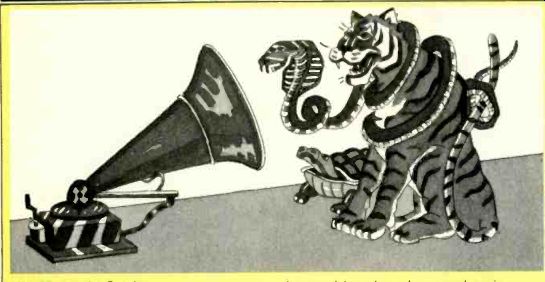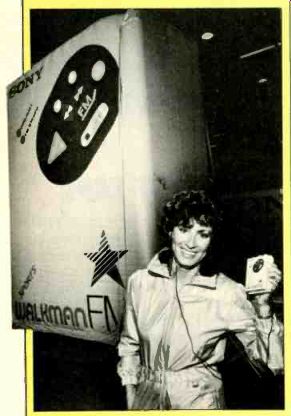FANGS ACROSS THE SEA
His Master's Snake

We all know the famous picture of the dog looking into the gramophone horn. It's been used as a logo for decades, by companies all over the world, which once were related: RCA here, Britain's HMV ("His Master's Voice," named after the painting they were first to use), JVC (Japan Victor Co.), and so on. But in India, the dog is considered unclean and so is replaced on record labels by a cobra, with a supporting cast of antelopes, tigers and turtles--or so I understand from a review of a recorded-music history book The Incredible Music Machine, edited by Jacques Lowe.
(The review appeared in TLS, The Times Literary Supplement of London.)
Walkman Progress

World freestyle ballet ski champion Jan Bucher shows how modern integrated circuits have shrunk the Sony Walkman, compared to the Class-A, all-tube original prototype behind her.
Subjectivity
As hardware and recordings improve, the differences one must listen for can become quite small.
While differences no one can hear are not worth pursuing, how audible must a change be to be worthwhile? If you can hear the difference (even if others you trust say they don't), and if you can hear it consistently, even when you weren't expecting to, then the difference is real. That leaves two questions: Is the difference really an improvement? And if so, is it worth its cost to you? With subtle differences, the first is often hard to call; the second, which depends on the price, your income, and your priorities, is only a little easier.
If you can't hear the difference, then you're faced with a dilemma.
Should you trust others' ears and buy it--with the risk that the difference either never did exist or that you'll never learn to hear it? Or should you pass it by, trusting that the difference never will be audible to you? It's a rough decision, especially as some subtle differences take a while to become aware of.
The choice is yours-and purely subjective.
The Importance of Being Imaged
Until stereo came in, the main focus of hi-fi design was on improving purely monophonic aspects of sound quality-reducing noise and distortion, extending and smoothing frequency response, expanding dynamic range. With stereo, two new factors entered: Ambience, the ability to reproduce the space in which the recording took place, and imaging, the reproduction of instrument locations within that sound field. As distortion, noise and frequency response come more and more under control, increasing attention has been devoted to these two new factors, especially imaging. To some audiophiles, it seems, imaging has become the touchstone by which the quality of equipment and recordings should be judged.
I agree with those who feel that imaging and ambience add to listening enjoyment and enhance the concert-hall illusion. But I don't quite agree with those who feel that imaging reproduces a concert-hall reality. I attend an average of 20 live musical events per year (all classical), and I find that, 'from most seats in the concert hall, imaging is far less precise than it is on good home systems.
In the concert hall, imaging is only really sharp when you sit fairly far up front, at least in the front half of the hall. From some seats there, the orchestra also subtends a wider angle than most home systems' speakers do, which makes the image much broader, as well. I usually sit farther back, where the sonic blend is better, the ambience richer-and the ticket prices cheaper. (Paying more would mean hearing less, by cutting me down to fewer tickets.) So imaging is often better at home--and a good thing, too, as that's your only clue to what is happening in the sound stage. In the concert hall, you can just look; in fact, you have to close your eyes to become consciously aware of what is happening sonically. (It's often for less "hi-fi" than you'd think.) It's the illusion, not the reality, that tight imaging fosters. That's just fine-as long as we know the difference.
(adapted from Audio magazine, aug. 1984)
= = = =